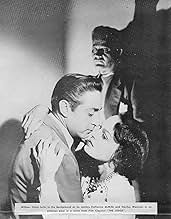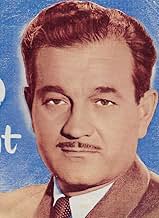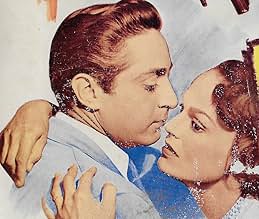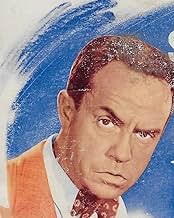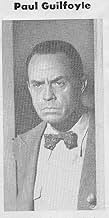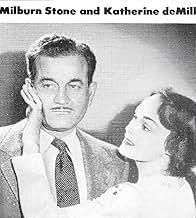Ajouter une intrigue dans votre langueA crooked lawyer blackmails a client into a murder plot against his wife.A crooked lawyer blackmails a client into a murder plot against his wife.A crooked lawyer blackmails a client into a murder plot against his wife.
Joseph Forte
- District Attorney
- (as Joe Forte)
Jess Kirkpatrick
- Patrolman Patrick Riley
- (as Jesse Kirkpatrick)
Al Rosman
- Crippled Victim
- (non crédité)
Histoire
Le saviez-vous
- AnecdotesDespite what the narrator say, it is the jury that decides the fate of the defendant and in this case "freed" the defendant. The attorney did not free him, the attorney merely defended him.
Commentaire à la une
...or: Well, that explains that.
In the exhibitor's press book issued with this film, there is a half-page, two-column story under this headline: Balance of Symbolism and Reality Is Important Facet of "The Judge" There we learn..."the delicate balance between symbolism and reality is one of the most interesting features of 'The Judge." While symbolism is used freely throughout, it infiltrates, rather than intrudes itself upon the consciousness of the audience. Instead of becoming an object in itself, a showcase for trick camera angles and self-conscious dramatic shots, the symbolism in 'The Judge' is worked in gently, a subtle shading to intensify the characters and action it supports. While the effectiveness of symbolism is exploited, it is made to keep its place in the anatomy of the picture."
(Thank goodness for small favors.)
"...Wiliam Jackson (Paul Guilfoyle), a little guy who is pushed around, is first seen in the uncompromising sunlight of a middle-class park, against the sculptured background of struggling figures at the base of a statue. He is trapped in the wire cage of a tennis court, and tried against the bleak bareness of a courtroom. All these backgrounds build unobtrusively toward making his actions in the contrasting Apartment 29 natural and even inevitable. They are an unspoken comment on, and explanation of, his character."
(A nerd is a nerd is a nerd)
"PROPS REVEAL CHARACTER: The office of Dr. James Anderson (Stanley Waxman), with its neat files and carefully cataloged data on human emotions, its stern furniture and well-ordered arrangement, portray the cold mind of the psychiatrist. Lucille Strang (Katherine deMille) is seen against a haughty background that shows the deft, impersonal hand of a professional interior decorator, artistically lovely but without warmth, showing she has spent money but no love upon it---pointing up her brittle and unsentimental character."
(Some of us clods just thought the dame had swell taste.)
"The props, too, speak their piece. Inanimate objects become characters in the story---Jackson's tinkle-toy that is crushed by the foot of an unheeding ruffian---the wire-recorder in Anderson's office that taunts Tilton (Norman Budd)---the gun that Strang steals from Anderson."
This course in fundamental symbolism ends rather abruptly right there, as if the printer had had all he could take, and just inserted a still of the scowling, bow tie-wearing Paul Guilfoyle in place of setting the type for a third column. Too bad. Perhaps the third column explained just exactly what a tinkle-toy was. Maybe it was a bedpan constructed out of tinker-toys from an Erector Set.
Did the writers explain all this to director Elmer Clifton?
In the exhibitor's press book issued with this film, there is a half-page, two-column story under this headline: Balance of Symbolism and Reality Is Important Facet of "The Judge" There we learn..."the delicate balance between symbolism and reality is one of the most interesting features of 'The Judge." While symbolism is used freely throughout, it infiltrates, rather than intrudes itself upon the consciousness of the audience. Instead of becoming an object in itself, a showcase for trick camera angles and self-conscious dramatic shots, the symbolism in 'The Judge' is worked in gently, a subtle shading to intensify the characters and action it supports. While the effectiveness of symbolism is exploited, it is made to keep its place in the anatomy of the picture."
(Thank goodness for small favors.)
"...Wiliam Jackson (Paul Guilfoyle), a little guy who is pushed around, is first seen in the uncompromising sunlight of a middle-class park, against the sculptured background of struggling figures at the base of a statue. He is trapped in the wire cage of a tennis court, and tried against the bleak bareness of a courtroom. All these backgrounds build unobtrusively toward making his actions in the contrasting Apartment 29 natural and even inevitable. They are an unspoken comment on, and explanation of, his character."
(A nerd is a nerd is a nerd)
"PROPS REVEAL CHARACTER: The office of Dr. James Anderson (Stanley Waxman), with its neat files and carefully cataloged data on human emotions, its stern furniture and well-ordered arrangement, portray the cold mind of the psychiatrist. Lucille Strang (Katherine deMille) is seen against a haughty background that shows the deft, impersonal hand of a professional interior decorator, artistically lovely but without warmth, showing she has spent money but no love upon it---pointing up her brittle and unsentimental character."
(Some of us clods just thought the dame had swell taste.)
"The props, too, speak their piece. Inanimate objects become characters in the story---Jackson's tinkle-toy that is crushed by the foot of an unheeding ruffian---the wire-recorder in Anderson's office that taunts Tilton (Norman Budd)---the gun that Strang steals from Anderson."
This course in fundamental symbolism ends rather abruptly right there, as if the printer had had all he could take, and just inserted a still of the scowling, bow tie-wearing Paul Guilfoyle in place of setting the type for a third column. Too bad. Perhaps the third column explained just exactly what a tinkle-toy was. Maybe it was a bedpan constructed out of tinker-toys from an Erector Set.
Did the writers explain all this to director Elmer Clifton?
Meilleurs choix
Connectez-vous pour évaluer et suivre la liste de favoris afin de recevoir des recommandations personnalisées
Détails
- Date de sortie
- Pays d’origine
- Langue
- Aussi connu sous le nom de
- The Gamblers
- Lieux de tournage
- Société de production
- Voir plus de crédits d'entreprise sur IMDbPro
- Durée1 heure 9 minutes
- Couleur
- Rapport de forme
- 1.37 : 1
Contribuer à cette page
Suggérer une modification ou ajouter du contenu manquant

Lacune principale
By what name was The Judge (1949) officially released in Canada in English?
Répondre

